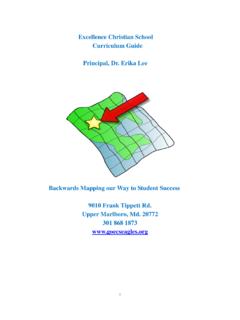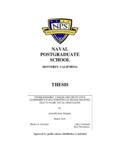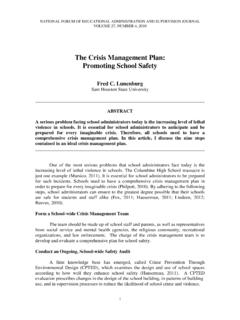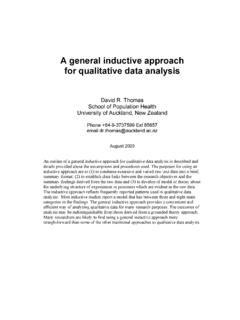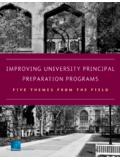Transcription of Eastern School District - Holy Spirit High School
1 Eastern School District COURSE DESCRIPTOR September 2007 Subject Area: Physical Education Course/Level: Intermediate - Grade 7 - 9 Authorized Learning Resources: Team Building Through Physical Challenges. By Glover & Midura. ISBN: 0873223594 Teaching Responsibility Through Physical Education by Hellison. ISBN :0736046011 Ready to Use Activities for Grades 7 9 by Landy & Landy. ISBN: 0136730620 Multicultural Folk Dance Treasure Chest, Volumes1 & 2 by Lane. ISBN # 0880119608 PSAP Sport Specific Booklets.
2 Teaching the Basics Resource Manuals (14 booklet set) by J W Sports, British Columbia: Recommended Learning Resources: Multicultural Games by Barbarash, ISBN: 0880115653 More Team Building Challenges by Glover & Midura ISBN: 0873227859 Great Games for Young People by Gustafson, Wolfe & King ISBN: 0873222997 Game Skills: A Fun Approach to Learning Sport Skills by Hanrahan ISBN: 0736002030 Best New Games by LeFevre ISBN: 0736036857 Inclusive Games by Kasser ISBN: 0873226399 Innovative Games by Lichtman ISBN.
3 0873224884 Physical Education for Children: Daily Lesson Plans for Middle School by Lee, Thomas & Thomas. Course Structure Student participation in a strong physical education curriculum is one of the key ways that overall wellness and positive attitudes towards physical activity and active living can be fostered and developed throughout life. The adolescence years are key to developing attitudes, habits, strong bones, high fitness levels, body awareness and various skills for a person s future years.
4 The Intermediate Physical Education Curriculum has been developed to meet the needs and interests of adolescent students and intermediate teachers. The intermediate physical education program extends the range of skills and knowledge acquired in the primary and elementary programs and facilitates transition to the more self-directed activities of high School . It builds upon the movement concept knowledge (Nichols, 1994) provided in the primary and elementary programs and provides opportunity for personal achievement through group and individual activities.
5 Key Features of the Intermediate Physical Education Curriculum include Provides opportunities for students to develop personal wellness, and personal movement skills that contribute to an active lifestyle throughout life. Provides opportunities to participate in a variety of activities Use of the levels of responsibility as described by Hellison (2003). Incorporates the three dimensions of movement: o Psychomotor (Understanding and Applying), o Affective (Thinking and Knowing) o Affective (Cooperation and Responsibility) COURSE DESCRIPTOR Subject Area: Physical Education Course/Level: Intermediate - Grade 7- 9 Teachers are directed to incorporate Hellison s Levels of Responsibility into their practice while teaching physical education.
6 Students and schools where students are encouraged and taught to assume greater amounts of responsibility for their actions, behaviour and learning, demonstrate much success in their learning. Hellison s Levels of Responsibility Level I (Respect), Level II (Participation), Level III (Self-direction) Level IV (Caring), Level V (Transfer of Responsibility), The intermediate program is designed around six themes; the yearly plan for each grade must cover ALL six themes. Since activities from each of the themes must be chosen at each grade level, a wide variety and balance of activities are provided.
7 A quality program will incorporate as many activities as possible to allow the students a full and enriching experience. Activities Minimum Maximum Alternative unit = 4 classes 2 units = 16 classes Court and Field unit = 4 classes units = 20 classes Fitness unit = 4 classes 2 units = 16 classes Leadership unit = 4 classes 2 units = 16 classes Outdoor unit = 4 classes 2 units = 16 classes Rhythmic unit = 4 classes 2 units = 16 classes * Teachers must address all 33 KSCO's by the end of grade 9.
8 * The themes and movement concepts are the vehicles through which the outcomes are met. * All six themes must be covered at each grade level each year EVALUATION: Note that full evaluative criteria is detailed in the Intermediate Physical Education Curriculum Guide Guiding Principles The Physical Education Evaluation Framework (Gr. 7 Level III) and the Newfoundland and Labrador Physical Education Assessment Tool (K Level III) form the basis for student assessment and evaluation in physical education.
9 A Students Evaluation reflects the extent to which curricular outcomes have been attained. Student evaluation will be based on active engagement in various activities and experiences. Each student who participates in Physical Education brings different experiences, skill sets, strengths, leadership and followership. A student s evaluation is personal and specific to the individual; every student has the opportunity for personal success in physical education. Evaluation Breakdown Students evaluation includes the three domains of movement Moving & Doing 50 % (25% dedicated to health/fitness) Understanding & Applying 25% Cooperation and Responsibility 25% All three (3) domains of movement (Moving & Doing, Understanding & Applying and Cooperation & Responsibility) are evaluated through participation in activities, games and various movement experiences, either individually or with fellow students.
10 Moving & Doing - 50% (25% dedicated to health/fitness) Psychomotor curriculum outcomes (Moving and Doing) form the core elements of a student s evaluation. It is the actual active engagement in activities that is the main determinant of a student s success and the focus of this evaluative Defining criteria for the Moving and Doing component include: Participates in a variety of activities Applies body mechanics in movement activities Engages in movement, motor and athletic skill development activities Engages in personal fitness activities o works to remain physically active o works on his/her health related fitness (cardiovascular, flexibility, muscular strength and endurance) o works on his/her skill related fitness (agility, coordination, balance, speed, power, reaction time) Notes on Fitness.


